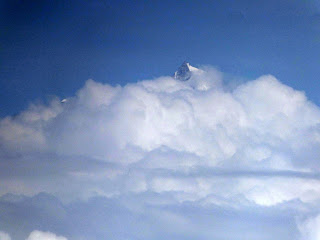We headed back past the Himalayan Mountain Institute to go further
down the mountain to visit a tea plantation (called tea garden here) and see
how tea is processed. On the way down, the clouds briefly cleared and we got a
glimpse on the snow covered mountain peaks.
 |
| Our only glimpse of the Himalayas on the entire trip. |
The tea garden was established in 1852 and still uses the
same machines to process the tea as they did then. The serious dryers are still
coal-fired. This is early in the harvesting season, so there were not a lot of workers around when we looked at the
plant. We got an introduction to how things worked, then walked through the
building.
 |
Pay information -- in addition to wages,
workers get food and sick pay. If they pick
more than the minimum leaf weight, they
get bonuses. |
|
 |
It's early in the picking season, so large rooms of drying
racks were empty. |
 |
| This one was partially used, |
 |
The dried leaves go down the chutes to a
leaf rolling machine. All the machines are
original from the start in the 1800s. |
 |
| These are bagged tea leaves, with markings denoting quality.. |
 |
| Original coal-fired ovens do light roasting. |
 |
| This is where the roasted leaves end up. |
 |
| Above and below: sorting facilities for the leaves. Big is better. |
 |
| Dumping the leaves according to their quality. |
At the end we tasted teas, in a process very unlike our stops at the
tea shop in Chinatown. Five
teas were pre-brewed and set out in cups with the brewed
tea leaves on display and information printed about the teas and their costs.
We each got plastic cups and spoons were placed in each tea cup so we could
spoon ourselves a couple tastes of tea. Unlike our Chinese teas, these were
brewed for 5 minutes and were uniformly very bitter (and tepid). We decided to
buy an oolong and intend to try it
the Chinese way when we get home and
hope we like it.
 |
This was the selection of teas we tasted, all of which were
too bitter, probably due to overbrewing, |
 |
| Worker residences past the fields |
 |
| The tea trees here are trimmed really short. |
 |
A worker weeds the tea trees for free in exchange for taking
the weeds home to his livestock for fodder. |
Then it was back to the hotel for a quiet afternoon. Jim is
working on resting his sore foot. I had hoped to catch up on the blog, but the internet connection was not cooperating. Chimi (our trip leader) came to our room with a bucket and herbs she had collected and proceeded to minister to Jim's sore foot. Some of the bruises look a bit better after the herb bath and massage.
Chimi had also arranged an impromtu visit to a local non-profit that teaches women various types of weaving and sewing to help them be able to support their families. While we were there, the founder dropped in, which was very interesting. She was critical of companies that hire women but don't provide child care and talked about the group's efforts to reduce domestic violence. On the way back, I picked up some chips and coke for Jim who is hungry for salt and sick of drinking water.
 |
A worker sews weavings from the backstrap looms into useful
products like purses and totes. |
 |
| This wide rug is being created by a team of two workers. |
 |
| This smaller rug has a much more complex pattern. |
 |
| This is backstrap loom, which supplies fabrics for the sewers, |
 |
In the public square near our hotel, a movie company build this
stage and is filming there. |
 |
| I went in search of chips and a coke for Jim in a busy lane. |
 |
Our hotel building: we are the second set of windows from
the top. We are on the ground floor in the front but the back
has 2 or 3 floors under us. |
The Weather Channel was forecasting 90-100% chance of rain all three days we were here and I think we got lightly showered on for a total of 15 minutes, despite all our walking. Even our drives were dry. The Bhutan forecast is also predicting rain and I am hoping their forecasters are as inept there as they were here!























No comments:
Post a Comment